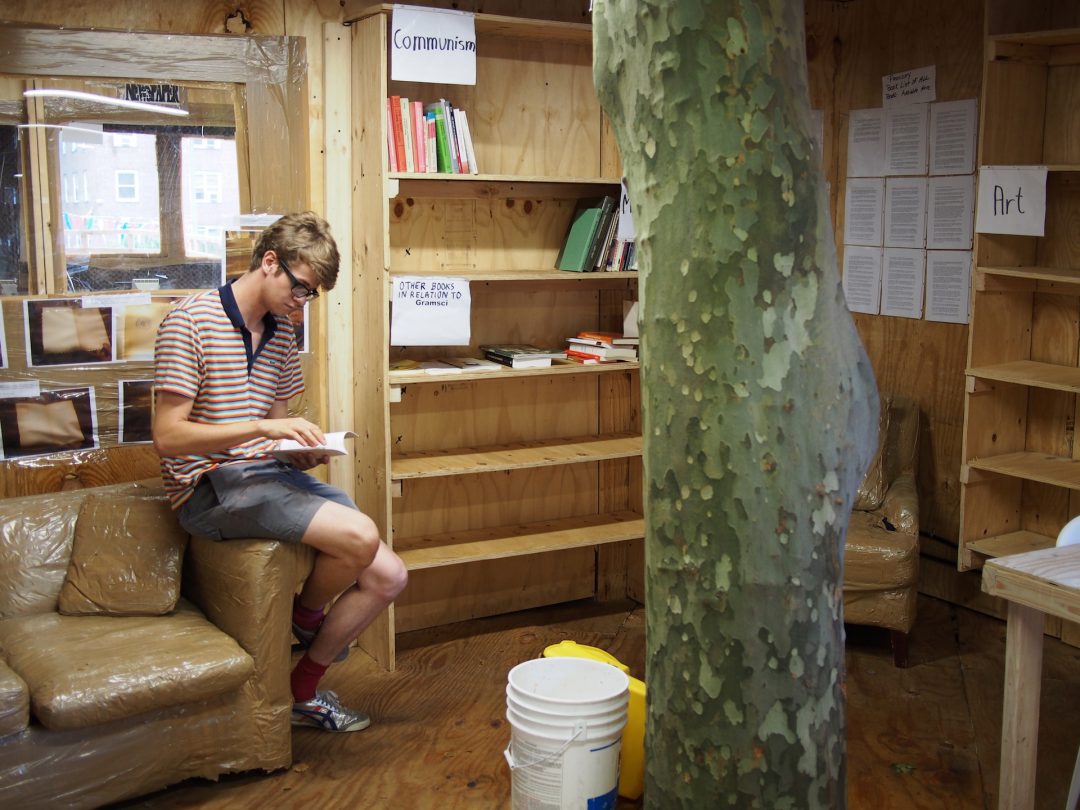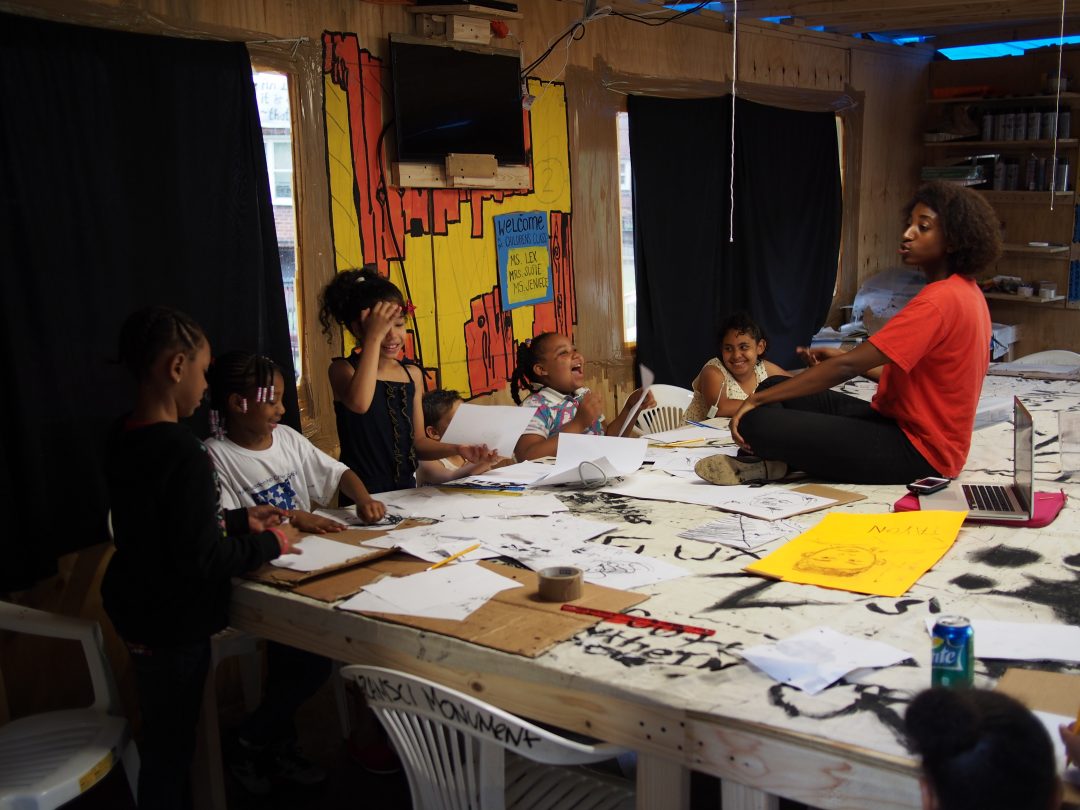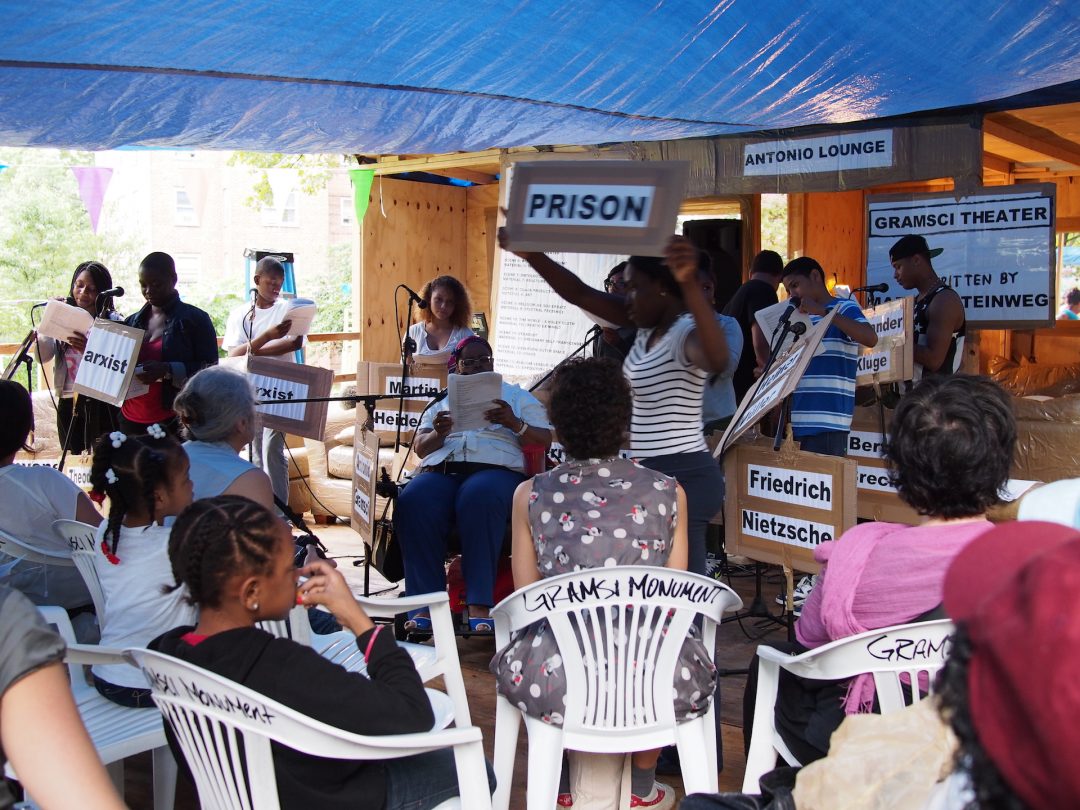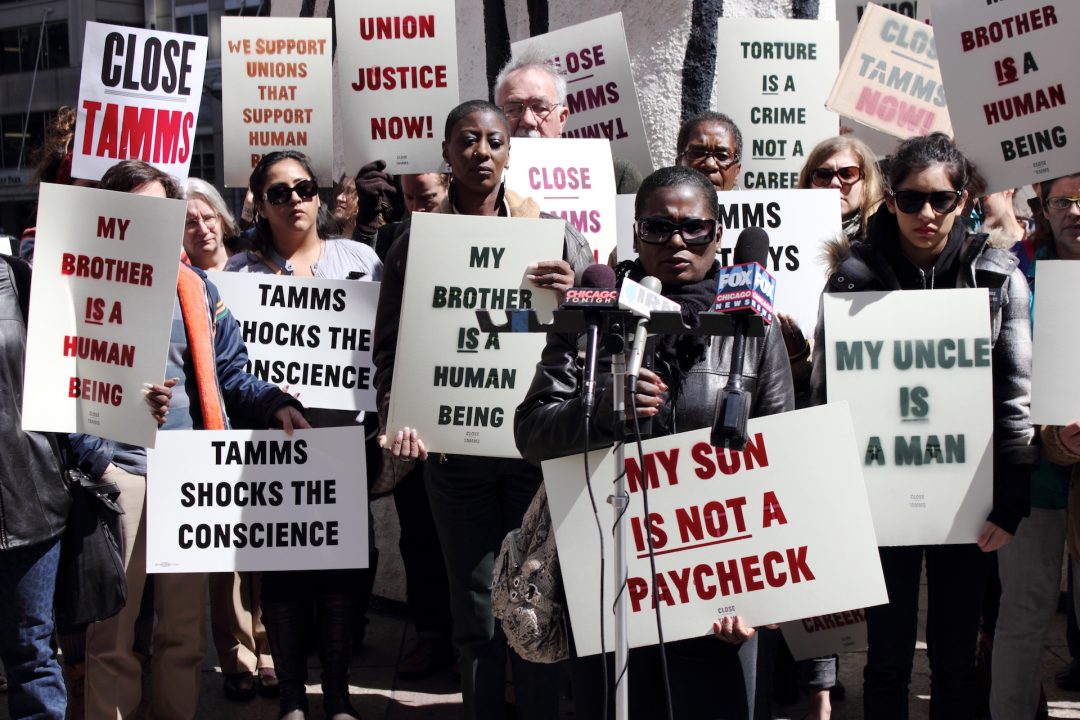The Short-Lived Empathy of the Participatory Work

“I want to do work that involves the other, that enables him to be active in his turn”, declares Thomas Hirschhorn.1 The participatory art that emerged at the end of the 20th century is a probe advancing towards otherness, encompassing it and perhaps devouring it. The empathetic brief of a social art finds a place at the heart of a praxis that does away with the division between artist, work, and viewer, thanks to visitor participation: everyone is listening to everyone, and everyone has their two cents’ worth to say. What are you thinking about? asks collaborative art. But the limits of such an endeavour are starting to be felt: has participatory art heard, one single time, the answer to the question it has just asked the supposedly active participants in the work?
In 2013, Thomas Hirschhorn’s Gramsci Monument was installed in the Bronx, in New York, in a courtyard at the low-rent housing complex called Forest Houses: lack of state investment, the unhealthiness of the premises, rampant unemployment, delinquency, and low school attendance all encircled the work which, for three months, had pride of place in some abandoned gardens, radiating the hope of an artistic and political democracy in the offing, a hope which swiftly fizzled when the work was taken down. And yet the cooperation with the inhabitants formed the nerve centre of the artist’s project: subsidized by the Dia Art Foundation, the monument dedicated to the Marxist Italian revolutionary Antonio Gramsci was constructed by neighbourhood residents, who were paid during the summer to occupy the place and enliven the installation. The intense collaboration between the artist and the residents was translated by the availability of shared services: the construction, made of wood and scotch tape, was rendered festive by a bar, a DJ’s cabin, and an Internet room which gave younger visitors a chance to access the web, while most neighbourhood homes had no such hook-up. The Gramsci Monument Newspaper was published on a daily basis, and regular lectures about Gramsci and art were organized, and attended, as one might expect, by Manhattan’s white intelligentsia.

Hirschhorn’s intent is to “engage in a dialogue with the other without neutralizing him”.2 And in effect the noise of the dialogue was very audible: the great other, the segregated person, entered the art not by way of representation but by introducing himself, which made the work especially empathetic. The power of the work lay in getting people to share different experiences and increase encounters that were previously impossible because of the economic, cultural and racial hermeticism of contemporary art circles. More precisely, the fact of developing a dialogue was empathetic insofar as what was involved was not sharing the same experience, but discovering the Other. Unlike emotional contagion, which is to say the diffusion of one and the same emotion within a group, empathy consists in giving presence to an emotion which is not one’s own. In this sense, it contrasts with the neutralization of someone else which takes the form of an emotion imposed from without. So in the case of an emotional neutralization, I am only able to understand someone else by analogy with my own feelings, which, as a result, stifles the singularity of what the other person feels. A non-empathetic work expresses what one must think, and live; it is like a user’s manual which summons the reader to comply with the steps necessary for the machine, designed in advance by the artist, to work properly. But Hirschhorn, with his concern not to bolster the solipsism of the predominant art world, asks himself a decisive question: “Am I working for a non-exclusive audience?”3 Including does not mean homogenizing; it is a matter of asserting the equal intelligence of the participants and, in so doing, tearing away the esoteric veil of contemporary art. For, in accordance with the central thesis of the Italian revolutionary brandished in his turn by the Swiss artist, “all people are intellectuals”.4 Egalitarian politics are based on an empathy thanks to which the singularity of another person—the fact that he cannot be reduced to the same—can find a site of emergence. Far from postulating that all people think the same thing, the intelligence shared by all men and all women signifies that everyone is able to think.

Hirschhorn’s empathy, which takes the form of a monument by way of which a dialogue with the other is embarked upon, is rooted in Gramsci’s thinking and, in particular, in the requisites necessary for the formation of the cultural hegemony of the dominated classes against exploitation. Hegemony consists in the production of a strategic coherence of the interests of all dominated people. At the root of this unity, which is not won in advance, lies the intellectual, whose role is to unify the masses by making them aware of their domination, whose objectivity is translated by the unequal distribution of the means of production within capitalist society. To do this, the intellectual must be endowed with a capacity to feel the people: “One does not get involved in history-politics without this passion, which is to say without this sentimental connection between intellectuals and people-nation”, Gramsci declared. Adding, straight away, that without such a connection, “the relations between the intellectual and the people-nation are reduced to relations which are purely bureaucratic and formal in nature; intellectuals become a caste and a priesthood”.5 By championing the common sense of the masses, Gramsci unflaggingly sought to destroy the elitism of revolutionary scholars and encourage the creative spontaneity of proletarian players. This sentimental connection—a warm one when compared with bureaucratic chilliness—is translated by Hirschhorn’s self-impeachment of his role as sole producer of the work: empathetic communion, in a collaborative context, is a sharing of the authorial gesture, thus letting the other’s voice be expressed, be it through newspaper articles, the DJ’s choice of music, or the whoops of children having fun in the computer room.

But in the midst of the clamour of everyone’s involvement, a silence could be heard which came from the future of that moment, from the moment when the work would only continue to exist in memory—from today, in a word. In reality, the empathy of the Gramsci Monument cannot be reduced to the sentimental connection advocated by Gramsci. While empathetic passion is short-lived, enrolment within the revolutionary party and taking over state power call for a real engagement, in the eyes of the militant-cum-philosopher, meaning a permanent action. Hegemony, albeit necessary, fades if it is not paired with the direct domination that proceeds by way of control of the monopoly of legitimate violence possessed by the State. After empathy there is the law—a power of authorization and interdiction without which the flash of a night (or of three months) instantly disappears when the status quo becomes the norm again. So the issue of the time span of the participatory work is the stumbling block for the ideas of the standard-bearers of the encounter with the Other by way of collaboration. For, at the end of the day, visitors from Manhattan went back home to Manhattan, and Hirschhorn went back to Paris. The monument was taken down; the month or two of uproar were forgotten; the encounter was fleeting and short-lived. Empathy gave birth to void. Worse still, it increased inequality by producing the illusion that something had been done. Good souls retreated into their certainty that they had acted properly; clear consciences brought the repose necessary after inaction. In the face of this gratifying spectacle of false otherness, well-heeled and cultivated visitors appreciated the unpleasant shiver that passed through them. By becoming involved for the length of a day, they were able to undertake their good action in order to do nothing. Empathy or not, one third of Bronx residents still live below the poverty level drawn up by the US government.
But how are we to dodge the trap of empathy which consists in producing just a form of clear conscience, in the wake of the artist’s ephemeral involvement? Other models of artistic involvement are possible, as is illustrated by the practice called ‘legislative art’ adopted by the American artist Laurie Jo Reynolds. Far from wanting to construct empathetic relations with the excluded and the segregated, Reynolds conducts a militant activity aimed at altering the legislative framework in place in order to introduce tangible solutions to a situation deemed to be unjust. In Illinois, the Tamms prison which was opened in 1998 was a place of brutal isolation where inmates did not have access to outside yards or to the prison’s communal areas, and many of them suffered from serious psychological disorders, sometimes leading to suicide. In 2008, artists, poets and musicians formed the Tamms Poetry Committee, with the intention of re-establishing communications with incarcerated people by way of letters, images and poems. But this action did not stop at an activity guided by the right feelings and the pious wish to put a stop to the ills suffered by the prisoners. The Tamms Ten Year Campaign was launched with the aim of raising the awareness of the people of Illinois about the inhumane situation in the prison and, above all, making those in power responsible for the perpetuation of the detention conditions. Lawmakers and the state governor were singled out during forums, press conferences and lobbying days organized by the collective, which joined forces with lawyers, prisoners, and their families. On 4 January 2013, the governor of Illinois took the decision to close the prison, in the wake of a budgetary crisis, but also following the condemnation pronounced by human rights organizations and, above all, because of pressure from the activists’ collective put together by Laurie Jo Reynolds.

Legislative art is radically opposed to the artistic participation championed by Hirschhorn. First and foremost, the inter-subjective link is no longer that of a friendly or personal relation mediated by discussion and listening. Although Reynolds was aware of the pain of the other, she related to it in an impersonal way by deciding to sort out the problem by the mediation of the law. Her decisive question was: are the other’s rights being respected? From then on, a new relation between art and the law was embarked upon: the artist is no longer defined as the transgressor outside the law, but they become, on the contrary, nothing less than a lawmaker. As a result, the notion of space and time of legislative art differs from that of participatory art. The artist does not elect to set up an instant micro-utopia in which violence temporarily ceases to be waged against the outcast, but seeks to bring in justice in a sustainable and lasting way over a huge territory. Once again, this calls for an active cooperation with the institutional power so that the application of measures is respected throughout the territory in question. Lastly, legislative art is based on a conception of the artist who is not a solitary, transnational and evanescent hero, but someone who remains at work within a collective in a familiar space.

So should we reject empathetic understanding outright? First and foremost, it behoves us to be acquainted with the sufferings and misfortunes of social groups assailed by poverty and State racism. In this sense, empathy might act as a method of acquaintanceship thanks to which university knowledge and artistic work might be renewed just when the ivory tower is collapsing. However, even if empathy is the foundation stone of our understanding of someone else’s suffering, it can only fight effectively against injustices provided that it finds a go-between in the legal institution which has the power to implement change and make it part of a lasting programme. So for the Gramsci Monument and all participatory works which, by their very nature, will die on the morrow, let us bear in mind the criticism that Hegel addressed to good souls, concerned with the unhappiness of others and yet resolved to do nothing about it: “Consciousness lives in dread of besmirching the splendour of its inner being by action and an existence; and, in order to preserve the purity of its heart, it flees from contact with the actual world, and persists in its self-willed impotence to renounce its self which is reduced to the extreme of ultimate abstraction, and to give itself a substantial existence, or to transform its thought into being, and put its trust in the absolute difference [between thought and being]”.6 For empathy to become really effective, by going beyond personal gratification and altering through the law the conditions of existence within a society divided into classes, splendour must be soiled—let us produce works which have the power of law.
1 Thomas Hirschhorn, Une volonté de faire, Paris, Macula, 2015, p. 67.
2 Ibid.
3 Ibid., p. 83.
4 Antonio Gramsci, Cahiers de prison (Cahier 12), Paris, Gallimard, 1978, p. 312.
5 Ibid., (Cahier 11), p. 299.
6 G. W. F. Hegel, Phenomenology of Spirit (1807), trans. A.V. Miller, Oxford, Clarendon, 1977, p. 400.
Image on top: Thomas Hirschhorn, Gramsci Monument, 2013. Gramsci Archive and Library, Forest Houses, Bronx, New York. Courtesy Dia Art Foundation. Photo: Romain Lopez.
Related articles
Paris noir
by Salomé Schlappi
Some white on the map
by Guillaume Gesvret
Toucher l’insensé
by Juliette Belleret

